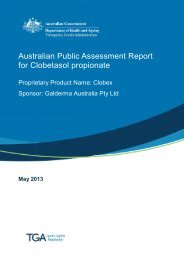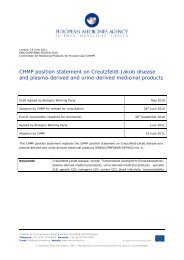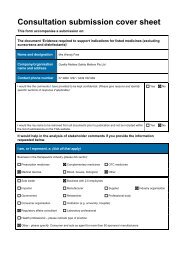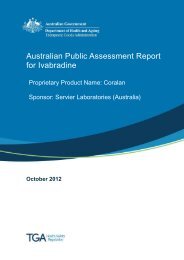Australian public assessment for Ibuprofen - Therapeutic Goods ...
Australian public assessment for Ibuprofen - Therapeutic Goods ...
Australian public assessment for Ibuprofen - Therapeutic Goods ...
Create successful ePaper yourself
Turn your PDF publications into a flip-book with our unique Google optimized e-Paper software.
Analysis populations<br />
AusPAR Caldolor <strong>Ibuprofen</strong> Phebra Pty Ltd PM-2010-02393-3-1<br />
Final 2 January 2013<br />
<strong>Therapeutic</strong> <strong>Goods</strong> Administration<br />
The Safety Analysis Population (SAP) comprised all randomised patients who received at<br />
least one dose of study medication.<br />
The Intention-To-Treat (ITT) population included all patients from the safety population<br />
who had a baseline <strong>assessment</strong> and at least one post-baseline evaluation of the primary<br />
endpoint.<br />
The Efficacy-Evaluable Population (EEP) at Hour 4 included all patients from the ITT<br />
population who had not received any excluded concomitant medication within the 4 h<br />
prior to first administration. The EEP at Hour 24 included all patients who had received at<br />
least 5 doses of study medication with no excluded concomitant medication(s) within the<br />
24-h treatment period.<br />
Statistical tests<br />
All statistical tests were two-sided, with p-values less than 0.05 <strong>for</strong> treatment differences<br />
and less than 0.10 <strong>for</strong> interaction effects considered significant.<br />
The principle analyses were per<strong>for</strong>med in the ITT population and supportive analyses<br />
were per<strong>for</strong>med in the EEP. These efficacy analyses were to be per<strong>for</strong>med without regard<br />
to illness severity stratum (critically ill or not critically ill at the time of randomisation) but<br />
the protocol also provided <strong>for</strong> optional analyses to be per<strong>for</strong>med separately on each illness<br />
stratum. These were not available in the main study report but were provided in the<br />
Integrated Summary of Efficacy (ISE). Additional analyses requested by the FDA were also<br />
included in the submission.<br />
Missing values were imputed using the last-observation-carried-<strong>for</strong>ward (LOCF) method.<br />
For patients declared as treatment failures and <strong>for</strong> patients who received corticosteroids<br />
or rescue treatment, temperature measurements subsequent to treatment with any<br />
corticosteroid or rescue treatment were substituted with the mean of the treatment group<br />
temperature <strong>for</strong> that corresponding time point. Linear interpolation was used to estimate<br />
the time to afebrility when a patient’s temperature was above 101.0°F at one time point<br />
and below 101.0°F at the next time point.<br />
The use of a critical p-value of 0.05 <strong>for</strong> the between-treatment comparison of the primary<br />
efficacy outcome is acceptable. Although there were 3 Caldolor dose groups (and thus 3<br />
potential comparisons with placebo) multiplicity was avoided by using only one of these<br />
(the 400 mg versus placebo comparison) as the primary outcome. As discussed later,<br />
however, this approach has implications <strong>for</strong> the sponsor’s proposal that the 200 mg dose<br />
should also be approved.<br />
Participant flow<br />
The report did not state the number of prospective participants who were screened. A<br />
total of 123 patients were randomised and progressed as follows:<br />
• SAP: 120 patients received study medication and were included in the SAP. The 3<br />
patients who did not receive study medication were discontinued prior to dosing due<br />
to poor venous access (n=1) or temperature drop to
















